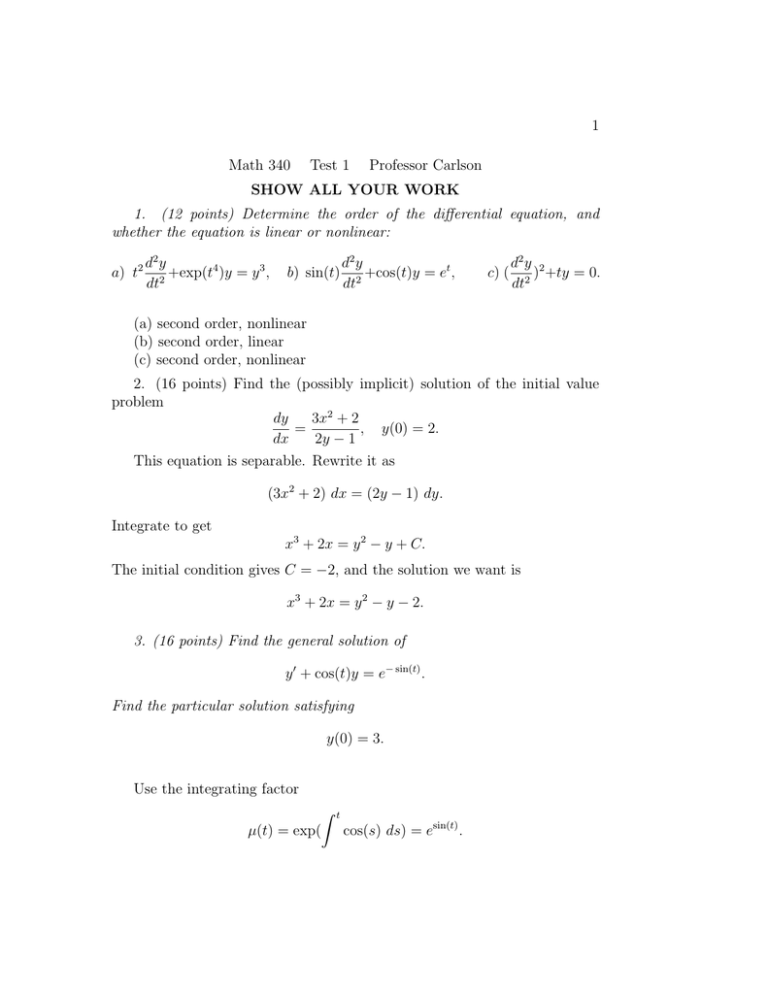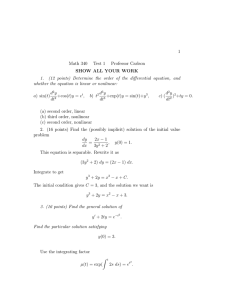1 Math 340 Test 1 Professor Carlson
advertisement

1 Math 340 Test 1 Professor Carlson SHOW ALL YOUR WORK 1. (12 points) Determine the order of the differential equation, and whether the equation is linear or nonlinear: a) t2 d2 y +exp(t4 )y = y 3 , dt2 b) sin(t) d2 y +cos(t)y = et , dt2 c) ( d2 y 2 ) +ty = 0. dt2 (a) second order, nonlinear (b) second order, linear (c) second order, nonlinear 2. (16 points) Find the (possibly implicit) solution of the initial value problem 3x2 + 2 dy = , y(0) = 2. dx 2y − 1 This equation is separable. Rewrite it as (3x2 + 2) dx = (2y − 1) dy. Integrate to get x3 + 2x = y 2 − y + C. The initial condition gives C = −2, and the solution we want is x3 + 2x = y 2 − y − 2. 3. (16 points) Find the general solution of y 0 + cos(t)y = e− sin(t) . Find the particular solution satisfying y(0) = 3. Use the integrating factor Z µ(t) = exp( t cos(s) ds) = esin(t) . 2 This gives (esin(t) y)0 = 1, esin(t) y = t + C, y = te− sin(t) + Ce− sin(t) . The condition y(0) = 3 gives C = 3, so y(t) = te− sin(t) + 3e− sin(t) . 4. (18 points) Consider the differential equation dy = f (y), dt f (y) = y(y 2 − 1). Sketch the graph of f (y) vs. y. Find the equilibrium solutions and determine whether the equilibrium solutions are unstable or asymptotically stable. Sketch the graph of solutions y(t) vs. t. The equilibrium solutions are y = 0, which is asymptotically stable, and y = ±1, both of which are unstable. 5. (16 points ) Use Euler’s method to find a approximate solution of the initial value problem dy − y = 1, y(0) = 1 dt on the interval [0, 8]. Use the step size h = 2, so the sample times are t0 = 0, t1 = 2, t2 = 4, t3 = 6, t4 = 8. First rewrite the equation in standard form, dy = f (t, y) = y + 1. dt For Euler’s method, take y0 = y(0) = 1 and yn+1 = yn + h ∗ f (tn , yn ) = yn + 2 ∗ (yn + 1). We find y1 = 1 + 2 ∗ 2 = 5, y3 = 17 + 2 ∗ 18 = 53, 6. 22 points y2 = 5 + 2 ∗ 6 = 17, y4 = 53 + 2 ∗ 54 = 161. 3 A storage container has an internal temperature u(t). If v(t) is the external temperature, Newton’s Law of Cooling says that du = −k[u(t) − v(t)]. (1) dt Suppose the external temperature varies daily according to the formula v(t) = T0 + T1 cos(2πt), (2) where t has units of days. (a) Assuming v(t) as given in (2), find the general solution of (1). You may assume that Z t ekt k eks cos(πs) ds = 2 [k cos(πt) + π sin(πt)] − 2 . 2 k +π k + π2 0 Write (1) as du + ku = kv(t). dt The integrating factor is µ(t) = ekt . We find d kt e u = kekt v(t) = kekt [T0 + T1 cos(πt)]. dt Z t kt keks [T0 + T1 cos(πs)] ds, e u(t) = C + 0 so that u(t) = Ce−kt +T0 [ekt −1]e−kt + k2 T1 k [k cos(πt)+π sin(πt)]−T1 e−kt 2 . 2 +π k + π2 (b) Describe what happens to u(t) for very large times t. What is the long term influence of the initial internal temperature u(0). What is the average internal temperature over a long time period? The terms which are constants time the decaying exponential e−kt will have limit zero as t → ∞. Eventually the solution looks like u(t) ' T0 + T1 [k cos(πt) + π sin(πt)]. k2 + π2 Over long time periods the initial temperature, which determines C, has not effect. The average internal temperature is T0 because sin(t) and cos(t) have averages approaching zero.





